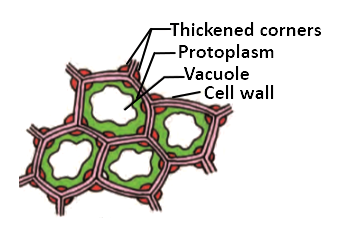Select Question Set:
Assertion(A): Monocotyledonous stems do not possess the ability to form secondary xylem and phloem tissues.
Reason(R): In monocotyledonous stems, cambium is present.
1. Both (A) and (R) are true and (R) is the correct explanation of (A).
2. Both (A) and (R) are true, but (R) is not the correct explanation of (A).
3. (A) is true, but (R) is false.
4. (A) is false, but (R) is true.
Subtopic: Vascular Tissue System |
87%
From NCERT
To view explanation, please take trial in the course.
NEET 2025 - Target Batch
Hints
To view explanation, please take trial in the course.
NEET 2025 - Target Batch
| Assertion (A): | Suberization leads to death of cell. |
| Reason (R): | Suberin is a water resistant material. |
| 1. | Both (A) and (R) are True and (R) is the correct explanation of (A). |
| 2. | Both (A) and (R) are True but (R) is not the correct explanation of (A). |
| 3. | (A) is True but (R) is False. |
| 4. | Both (A) and (R) are False. |
Subtopic: Anatomy of Root |
61%
Please attempt this question first.
Hints
Please attempt this question first.
Transverse section of a plant part shows conjoint and open vascular bundles. The transverse section is of:
| 1. | monocot root | 2. | monocot stem |
| 3. | dicot root | 4. | dicot stem |
Subtopic: Dicot Stem |
83%
From NCERT
Please attempt this question first.
Hints
Please attempt this question first.
The alternate terms used for ‘Phellogen’ and ‘Phellem’ respectively are:
| 1. | cork and cork cambium |
| 2. | cork cambium and cork |
| 3. | secondary cortex and cork |
| 4. | cork and secondary cortex |
Subtopic: Activity of Cork Cambium |
76%
From NCERT
Please attempt this question first.
Hints
Please attempt this question first.
In a plant, the protoxylem lies next to the phloem. This arrangement of xylem will be called:
| 1. | Stelar | 2. | Extrastelar |
| 3. | Endarch | 4. | Exarch |
Subtopic: Complex Tissue: Xylem |
63%
From NCERT
Please attempt this question first.
Hints
Please attempt this question first.
In dicot roots, initiation of lateral roots takes place in the cells of:
| 1. | Endodermis | 2. | Pericycle |
| 3. | Epiblema | 4. | Hypodermis |
Subtopic: Anatomy of Root |
82%
From NCERT
Please attempt this question first.
Hints
Please attempt this question first.
Identify the simple tissue of plants shown in the given figure:

1. Parenchyma
2. Collenchyma
3. Sclereids
4. Sclerenchyma fibres

1. Parenchyma
2. Collenchyma
3. Sclereids
4. Sclerenchyma fibres
Subtopic: Simple Tissue: Chollenchyma & Sclerenchyma |
89%
From NCERT
Please attempt this question first.
Hints
Please attempt this question first.
For the formation of interfascicular cambium and cork cambium the parenchyma cells first undergo:
| 1. | Differentiation | 2. | Dedifferentiation |
| 3. | Redifferentiation | 4. | Reverse differentiation |
Subtopic: Activity of Cork Cambium |
75%
From NCERT
Please attempt this question first.
Hints
Please attempt this question first.
Which of the following will not be true for gymnosperms?
| 1. | Gymnosperms lack vessels in their xylem. |
| 2. | Gymnosperms have albuminous cells and sieve cells. |
| 3. | Gymnosperms lack sieve tubes and companion cells. |
| 4. | Gymnosperms lack secondary growth. |
Subtopic: Complex Tissue: Xylem | Complex Tissue: Phloem |
74%
From NCERT
Please attempt this question first.
Hints
Please attempt this question first.
Match each item in Column I with one in Column II and select the correct match from the codes given:
Codes:
| Column I [Plant part] | Column II [Vascular bundle] | ||
| A | Dicot root | P | Conjoint and open |
| B | Monocot root | Q | Conjoint and closed |
| C | Dicot stem | R | Radial, exarch, 2-6 in number |
| D | Monocot stem | S | Radial, exarch, polyarch [more than 6] |
| A | B | C | D | |
| 1. | R | S | Q | P |
| 2. | R | S | P | Q |
| 3. | P | Q | R | S |
| 4. | Q | P | S | R |
Subtopic: Anatomy of Root | Dicot Stem | Monocot Stem |
83%
From NCERT
Please attempt this question first.
Hints
Please attempt this question first.
Select Question Set:






